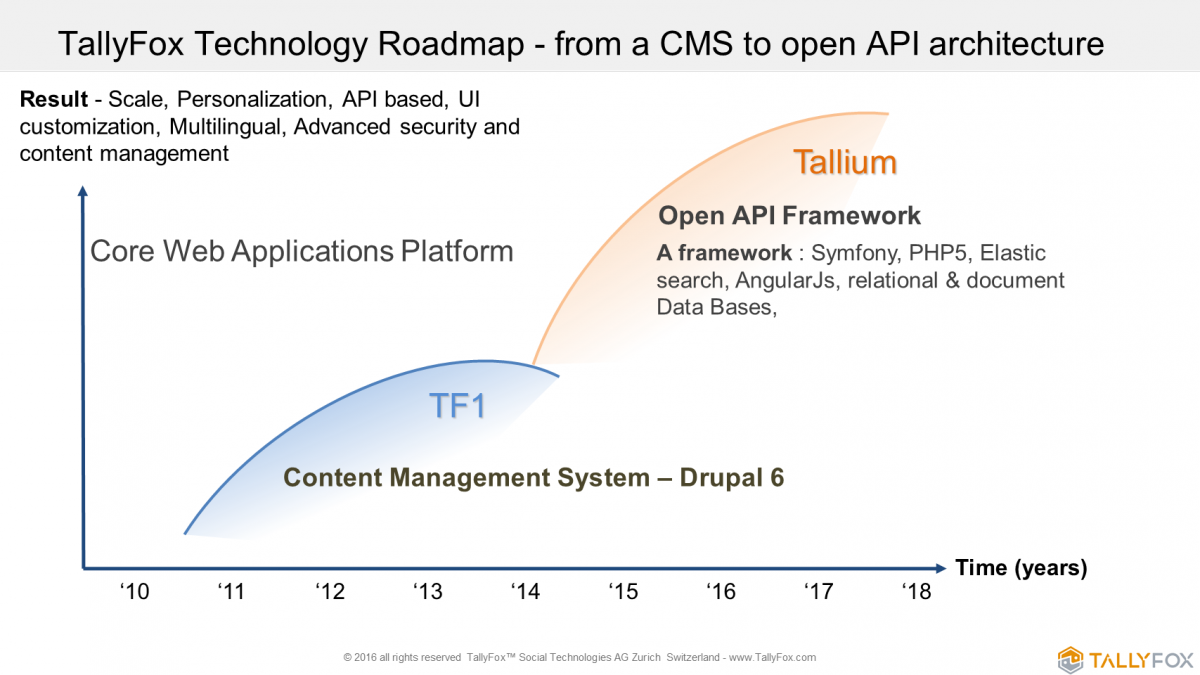Why we transitioned from a Drupal CMS to an API-based Architecture

At TallyFox we have a Vision to “Bring together the collective intelligence of professionals to create a better future”. Our solution is a contextual knowledge sharing platform to make it happen. Drupal was a perfect fit for what we envisioned.
Our journey from a Drupal CMS-based, knowledge sharing platform to an API-based architecture, knowledge sharing platform has given us incredible insight into the industry, and we would like to share it with you.

So let’s go.
When we were first designing a solution, Drupal was THE best way to go. After all, when it was officially released in February 2008, Drupal 6 promised to be “the easiest version of Drupal ever”, backed up by its plethora of tools and features that were supposed to change the open source world forever.
For us, Drupal seemed ideal.
It was open-source with a big community behind it and most of the functionalities were already developed in their modules or could be developed easily.
It was a fast prototyping version we needed to confirm our business model, and we believed that we could further advance our solution with it.
So what was the issue with Drupal?
Let’s start with Bootstrap. For each page requested Drupal executes the entire bootstrap process. We had around 270 modules and they were all connected which implies that the whole code was read each time you open a page. There wasn’t an option for only a part of the code to be read. This brought up speed issues which we were able to resolve after a year of hard work.
But the number of modules brought up security issues as well and we weren’t happy about them either.
You need to know that the Drupal template engine is very aged, and very slow in Drupal 6 and 7, and our platform had a lot of custom template files. Not all modules worked the same way when moving from one version to the next. As we worked on the platform, it became more and more bloated and technically difficult to maintain every time a new feature or option was added to it. This made a personalised solution nearly impossible if we wanted the platform to meet our standards.
Also, as the numbers of client communities rose, system load rose as well and it wasn't scalable going forward. It came down to changing Drupal, BUT, if we’re already working on adjusting Drupal, why not choose a framework and build a new architecture? We chose Symfony.
One of the deciding factors was that our potential clients had specific needs in terms of how they wanted to start and grow their communities. Some of them already had a legacy software that they didn’t want to give up on and there is also a prevalence of many consumer apps that are moving into the business world that needed to be integrated.
We needed an API-based architecture if we wanted to evolve to support the communities of future which require to be personalised so each person gets information specific to their interests; configurable, highly integrated through APIs, and compatible going forward.
An API-based architecture essentially acts as a lego platform, where you can attach different lego blocks in order to build exactly what you need. This also means that you can easily add or replace specific components without necessarily having to waste the work done on the existing ones.
With Drupal it was difficult to even rename a feature. Now we can not only rename a feature, we can configure the whole platform.
Why is an API-based architecture the right solution for us?
We envisioned an open-knowledge concept - A knowledge sharing platform where knowledge is not siloed, but shared across instances and brought to you through contextual knowledge sharing. We enriched it with Smart Match Pro, our algorithm, which only flourished when we included technologies such as graph-base to make sure that relevant content is delivered to platform's users, and the relevance percentage is calculated based on your industry expertise.
When we say contextual knowledge sharing, we mean it's not just that the information is suggested to you: It's all the aspects around it which give it "context" - Who shared it, how is it ranked and tagged and how it is relevant to you.
It took us a couple of years, and in May 2015 we officially launched Tallium, an API-based architecture, knowledge sharing platform. Looking back at Drupal 7 and Drupal 8, we made the right decision.


Comments
Leave a comment